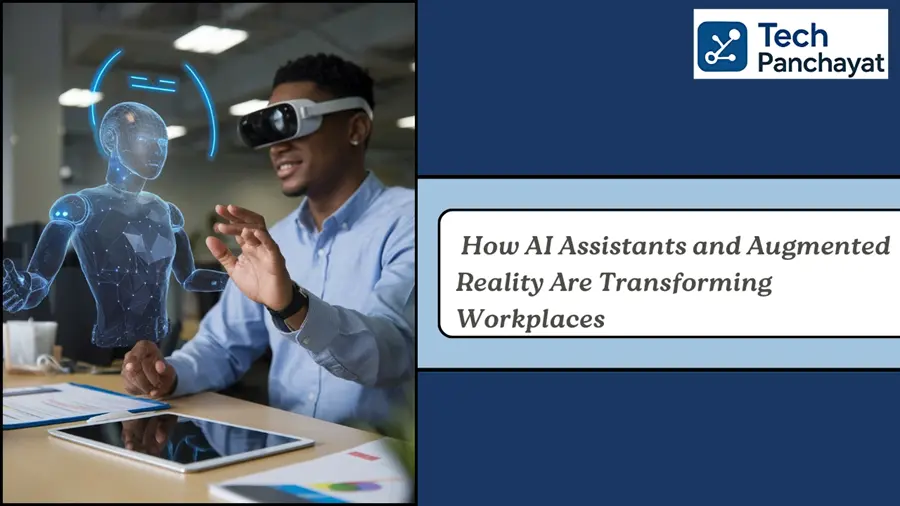The workplace as we know it is changing fast. Thanks to the rise of Artificial intelligence assistants in the workplace and augmented reality (AR) tools, companies are revolutionizing how work gets done. From streamlining routine tasks to creating immersive experiences for training and collaboration, technology is reshaping productivity and creativity in ways never imagined before.
Gone are the days when office tools were limited to emails, spreadsheets, and video calls. Today, AI-powered virtual assistants handle scheduling, reminders, and follow-ups, while AR provides interactive, real-time guidance for employees, no matter where they are. For companies, this means faster decision-making, smoother workflows, and better employee engagement. For employees, it means spending more time on strategic and creative work rather than repetitive tasks.
In this blog, we’ll dive deep into the impact of AI and AR on modern workplaces, explore their applications, examine their synergy, and discuss challenges organizations face when adopting these technologies. Whether you’re a manager looking to improve productivity, an employee curious about workplace tech, or a tech enthusiast, this guide will give you a clear picture of the future of work.
Artificial Intelligence assistants: Boost Productivity and Streamline Workflows
assistants are no longer just a futuristic concept, they are now part of daily workflows in offices across industries. From startups to multinational corporations, these tools are proving their worth in managing time, communication, and routine tasks.
Key Applications of AI Assistants
- Smart Scheduling: AI assistants analyze calendars, time zones, and priorities to schedule meetings efficiently, reducing the endless back-and-forth emails.
- Email and Task Management: Prioritizing emails, flagging urgent tasks, and even drafting responses, AI helps employees stay on top of their workload.
- Automation of Routine Tasks: From generating reports to updating databases, AI assistants free up valuable time for employees to focus on higher-impact tasks.
Supercharge Efficiency with AI
Studies show that employees using AI assistants spend less time on administrative work and more on strategic activities. According to Inc.com, AI assistants can even reduce stress and improve focus, especially during hectic periods. For businesses, this translates into measurable productivity gains and a more motivated workforce.
Augmented Reality Tools: Transform Training and Collaboration
While AI handles cognitive tasks, augmented reality tools enhance how we interact with our physical environment. AR overlays digital information onto the real world, creating immersive experiences that can revolutionize training, collaboration, and operations.
AR in Action
- Employee Training & Onboarding: AR enables interactive simulations, allowing employees to learn processes in a controlled, virtual environment before applying them in reality.
- Remote Assistance: AR glasses or apps allow experts to guide technicians remotely by overlaying instructions, diagrams, or alerts directly into their field of view.
- Product Design & Prototyping: Designers and engineers can visualize 3D models of products, adjust designs in real time, and collaborate seamlessly across locations.
Benefits for Organizations
AR helps reduce errors, accelerates learning curves, and improves operational efficiency. For example, AR-guided maintenance reduces downtime by giving technicians step-by-step instructions while they work, enhancing both accuracy and speed.
How AI and AR Work Together
Integrated Workflows
Imagine an AI assistant scheduling a maintenance task while AR guides execution. This integration reduces human error, improves efficiency, and provides a seamless workflow.
Enhanced Collaboration
Hybrid and remote work models benefit tremendously from AI and AR. Teams can collaborate in real time with AI organizing tasks and AR providing interactive guidance. This combination bridges the gap between physical and digital collaboration, making remote teamwork just as effective as working on-site.
Data-Driven Insights
AI analyzes data collected through AR applications to provide actionable insights, optimize operations, and predict potential issues before they arise. This ensures that companies are not just reacting to challenges but actively improving processes continuously.
Challenges in Adopting AI and AR
Privacy and Security
AI and AR technologies collect and process vast amounts of sensitive data, including personal and behavioral information. This makes them prime targets for cyber threats and unauthorized access. Organizations must prioritize robust data protection measures, encryption, and compliance with regulations like GDPR or CCPA to maintain trust and avoid costly breaches or legal penalties.
Employee Adaptation
New technologies like AI and AR can be overwhelming, especially for employees unfamiliar with digital tools. Without proper guidance, this can lead to resistance or underutilization of the technology. Companies should invest in comprehensive training programs, create clear usage guidelines, and offer ongoing support to ensure a smooth transition and foster a culture of innovation.
Costs
Implementing AI and AR often involves substantial initial costs, including hardware, software, and training expenses. However, these investments can yield significant long-term benefits such as increased efficiency, reduced errors, and enhanced customer experiences. Organizations must conduct a thorough cost-benefit analysis to ensure the investment aligns with their strategic goals and delivers measurable ROI over time.
AI vs AR in the Modern Workplace
| Technology | Primary Use Cases | Key Benefits |
|---|---|---|
| AI Assistants | – Smart scheduling and calendar management – Email and task prioritization – Automating repetitive tasks and reporting – Data analysis and insights | – Increased productivity – Reduced administrative workload – Better decision-making – Enhanced focus on strategic work |
| Augmented Reality (AR) | – Interactive training and onboarding – Remote technical assistance – Product design and prototyping – Immersive collaboration | – Faster learning and reduced errors – Improved remote collaboration – Real-time visualization – Enhanced operational efficiency |
| AI + AR Integration | – AI schedules tasks while AR guides execution – Remote expert assistance with AI insights – Data-driven workflow optimization | – Seamless workflow management – Reduced human error – Enhanced collaboration and decision-making – Higher overall productivity |
The Future of Work is Here
AI assistants and augmented reality tools are no longer optional they are becoming essential for organizations aiming to stay competitive. By automating mundane tasks and enhancing human capabilities, these technologies enable employees to focus on creativity, strategic planning, and innovation.
Organizations that adopt AI and AR early gain a competitive edge through higher productivity, better collaboration, and smarter decision-making. As workplaces continue to evolve, the integration of AI and AR will redefine how work is performed and experienced.
At Techpanchayat, we stay ahead of these trends, bringing you insights on how technology is shaping the future of work, so you can make informed decisions and leverage innovation effectively.

